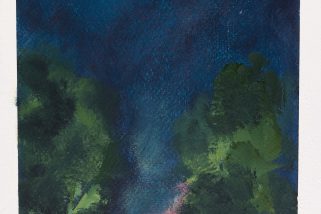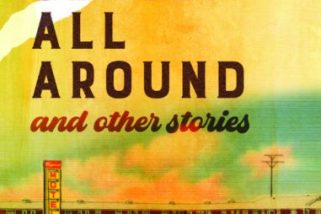
“Unmaking the Form” by Marya Hornbacher
Professor Firchow was a giant even when seated, like a bear who towers even when on all fours, and he had enormous hands that gestured slowly, gently, as a bear might gesture if it did. He spoke to us softly of Modernism, and the end of narrative arc, and multiple selective omniscience, and the poetics of fragmented time. I was a snippet of a girl, not yet twenty, shy and a little stunned by the sheer joy and terror of existence and afraid of everything and very brave. I tied myself into a compact knot in my chair, scribbling notes and peering out from behind my limbs at the looming Firchow.
And now, he said with a sigh of contentment, we come to Virginia Woolf.
In those years I slept too little, smoked too much, ate canned potatoes, and fed the cat beans when I was broke. I remember the shadow of my hands turning the pages in the circle of light cast by the crooked lamp on the desk at the third-floor walkup where I was learning to live in a room of my own. And I remember Mrs. Dalloway, whom I referred to only by her proper name; it feels impertinent to call her Clarissa even now; and I remember the tremor I felt when I read the fragile, triumphant opening words: “Mrs. Dalloway said she would buy the flowers herself.”
“I am made and remade continually,” Woolf wrote in The Waves, and in writing I find I am unmade and remade continually, again and again becoming a writer and a woman I don’t always know. The practice of writing shapes and makes me just as much as I make and remake my work. In order to undergo the writing process, I must be willing both to explore, and to be explored. I must break through the crust of the self I know, and bore down into the strata of selves below. And I need to lay myself open to that excavation. If I am to slip into other selves, see from unfamiliar points of view, speak with new voices that have new things to say—I need to allow those deeper layers to be explored.
It probably was Virginia Woolf who showed me that the act of writing—not just writing of my own experiences, but writing at all—would require a kind of bravery I did not then possess. I still am unsure whether I have the guts to write. What I had, and have, what Woolf’s work sparked in me, was the desire to write, the desire to tell stories, bear witness, give voice. I wanted to write about women, and as a woman. What I found in Woolf’s work was precedent, evidence, that I could do that—proof that a woman’s voice was enough, a woman’s story enough, a woman in herself enough—I heard a voice that was witness to the worth of a woman’s life.
Woolf sees through the eyes of the kaleidoscopic self, looking out at the world as it appears for only an instant, before its fragments gather and scatter again. She moves fluidly between the shifting, uncertain selves she inhabits more than she creates. When I read Mrs. Dalloway, I was drawn into that habitation of other bodies, that perspective of minds not my own. I found myself not looking at Clarissa but out from within Clarissa, an experiential point of view that felt both faintly familiar to me and utterly unknown.
This novel, and Woolf’s entire body of work, testify to the significance of tiny things—an instant, a passing thought, a single day—specifically, the significance of one woman’s story, no matter how simple or brief. The interior monologue, the open plot, the infinitesimal, nearly invisible transformations that we undergo and create in our wake as we move—these were all things that James Joyce had, to an extent, explored in Ulysses a few years before Mrs. Dalloway was published; but it took Joyce really quite a lot of pages, and put Harold Bloom’s average day on par with a Homeric epic. While I had wandered through Ulysses happily enough, it was Woolf who pulled the thread and unraveled the rest, who made and unmade and remade the form, who undid narrative, story, subject, the sentence itself. Hers was not the first work to play with time or speak of war, not the first to explore the intimate connections and stark divides between human souls; but hers was the first work I had ever encountered that explored a woman’s life from within; not her drawing rooms and manners, but the raw inside of her senses, and the cacophony of her mind.
And, for me, it was Woolf who toppled what I had been taught, who ruined what I thought you were supposed to write, and what you were supposed to write about—and whether I was allowed to write at all.
Recently I have found myself restless within the strictures of what I have been taught and trained myself to write. I am writing my way into forms I know nothing about. I don’t know how to write anything I’m writing. I don’t know what I’m going to write before I write it, or when it will be done. This is unnerving. But I know that when I am restless, I need to go where my feet want to go; when my voice and vision change, I must change with them; I must let form follow not from the forms I know, but from whatever form they find that fits; I must always remake the writing, and let the writing make and remake me.
In those simple rooms of my own, where I was that young woman, half a life ago, I sat alone: hesitating—faltering—writing—and I am still there. I am still her, hesitating, unsure, and secretly terribly brave. And sometimes, as it did with Clarissa, that enormous bravery rises up and crashes over me and I say: I will write the book myself.
____________________
Share your response to this work, in any form, here

Photo by Mark Trockman
Marya Hornbacher Artist Statement:
Marya Hornbacher is an award-winning essayist, journalist, novelist, poet, and survivor. Five of her books have been named New York Times bestsellers. She is best known for authoring “Wasted: A Memoir of Anorexia and Bulimia.”
Her writing encompasses many topics, including bulimia, anorexia, recovery, mental health, addiction, and spirituality. Marya is hard at work on a seventh book, a collection of essays the subject of solitude in women’s lives.






